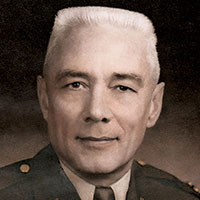DOWNLOAD
The May 1953 de-federalization of the reserve 301st Radio Broadcasting and Leaflet (RB&L) Group in the Federal Republic of Germany (FRG) forced U.S. Army, Europe (USAREUR) to resolve the issue of remaining 301st soldiers and equipment. On 14 May 1953, USAREUR Headquarters, Area Command (HACOM) issued General Order #22. That order set 20 May as the activation date for the 7721st RB&L, the strategic psychological warfare (Psywar) replacement for the 301st.1 However, the 7721st was just a short-lived holding detachment that was deactivated in September 1953, closing out the Army strategic Psywar presence in Europe for years.
Upon activation, the 7721st RB&L was to organize according to the USAREUR-created Table of Distribution (T/D) 77-7721, which was modeled on existing T/Ds for RB&L Groups. Because the 301st had that structure, the 7721st did not have to re-organize. The ‘newly formed’ 7721st would occupy the former barracks of the 301st (Sullivan Barracks), with the exception of one MRB detachment situated at the Vogelweh Cantonment in Kaiserslautern that was relaying American Forces Network broadcasts to soldiers under Western Area Command.2

On 1 June 1953, formal assignment of 301st personnel and property to the 7721st happened “smoothly and efficiently.”3 COL Frank A. McCulloch, 301st RB&L commander from September 1952 to May 1953 who then became the 7721st RB&L commander, told his subordinates that only the Group number had changed. “Personnel, equipment, and the mission remain the same, and it is my earnest hope that the new Group will carry on in the old tradition, in spite of the change in designation.”4 Soldiers noticed no difference in their day-to-day routines.
One soldier who served in both the 301st and 7721st RB&Ls was native Lithuanian Private First Class (PFC) Vytenis Telycenas. Drafted in 1952 while residing in Cleveland, Ohio, Telycenas took basic training at Fort Knox, Kentucky, before specializing in signal and radio communications. In late 1952, he reported to the 525th Military Intelligence Service Group at Fort Bragg, North Carolina. He soon received orders to the 301st RB&L Monitoring Section. When the 301st ‘became’ the 7721st, Telycenas recalled that nothing changed: “Everybody kept doing the same jobs.”5
The 7721st maintained the same research and training focus as the 301st, continuing some of the latter’s projects. The Group printed Propaganda Review, a product initiated by the 301st months prior thatoffered a daily summary of broadcasts by Radios Moscow, Warsaw (Poland), Prague (Czechoslovakia), (East) Berlin, Brasov (Romania), and Bucharest (Romania). In addition, it produced Propanol, a monthly analysis of broadcasts intercepted from the Communist bloc. According to the unit newsletter, Psyche, the purpose of Propanol was “obtaining intelligence to oppose [Communist] propaganda.” Monitors tuned in twenty-four hours a day to broadcasts from behind the Iron Curtain, recorded relevant broadcasts, and forwarded them to linguists for translation. Translated tapes then went for transcription and finally to the S-2 for a “strategic analysis and forecast.”6
